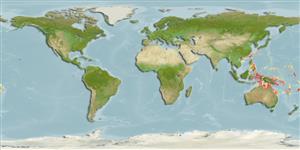Actinopterygii (ray-finned fishes) >
Perciformes (Perch-likes) >
Microdesmidae (Wormfishes) > Ptereleotrinae
Etymology: Oxymetopon: Greek, oxys = sharp + Greek, metopon = brow (Ref. 45335). More on author: Bleeker.
Environment / Climate / Range
Ecology
Marine; reef-associated; depth range 15 - 40 m (Ref. 90102). Tropical, preferred ?
Distribution
Countries | FAO areas | Ecosystems | Occurrences | Point map | Introductions | Faunafri
Western Central Pacific.
Size / Weight / Age
Maturity: Lm ? range ? - ? cm
Max length : 18.0 cm SL male/unsexed; (Ref. 48637)
Short description
Morphology | Morphometrics
Inhabits deep muddy slopes, subject to strong currents. Usually seen in small groups, often of mixed sizes (Ref. 48637).
Life cycle and mating behavior
Maturity | Reproduction | Spawning | Eggs | Fecundity | Larvae
Larson, H.K., 2001. Microdesmidae. Wormfishes, dart-gobies, fire gobies. p. 3607-3608. In K.E. Carpenter and V. Niem (eds.) FAO species identification guide for fishery purposes. The living marine resources of the Western Central Pacific. Vol. 6. Bony fishes part 4 (Labridae to Latimeriidae), estuarine crocodiles, sea turtles, sea snakes and marine mammals. FAO, Rome. (Ref. 48398)
IUCN Red List Status (Ref. 115185)
CITES (Ref. 94142)
Not Evaluated
Threat to humans
Harmless
Human uses
More information
CountriesFAO areasEcosystemsOccurrencesIntroductionsStocksEcologyDietFood itemsFood consumptionRation
Common namesSynonymsMetabolismPredatorsEcotoxicologyReproductionMaturitySpawningFecundityEggsEgg development
Age/SizeGrowthLength-weightLength-lengthLength-frequenciesMorphometricsMorphologyLarvaeLarval dynamicsRecruitmentAbundance
ReferencesAquacultureAquaculture profileStrainsGeneticsAllele frequenciesHeritabilityDiseasesProcessingMass conversion
Tools
Special reports
Download XML
Internet sources
